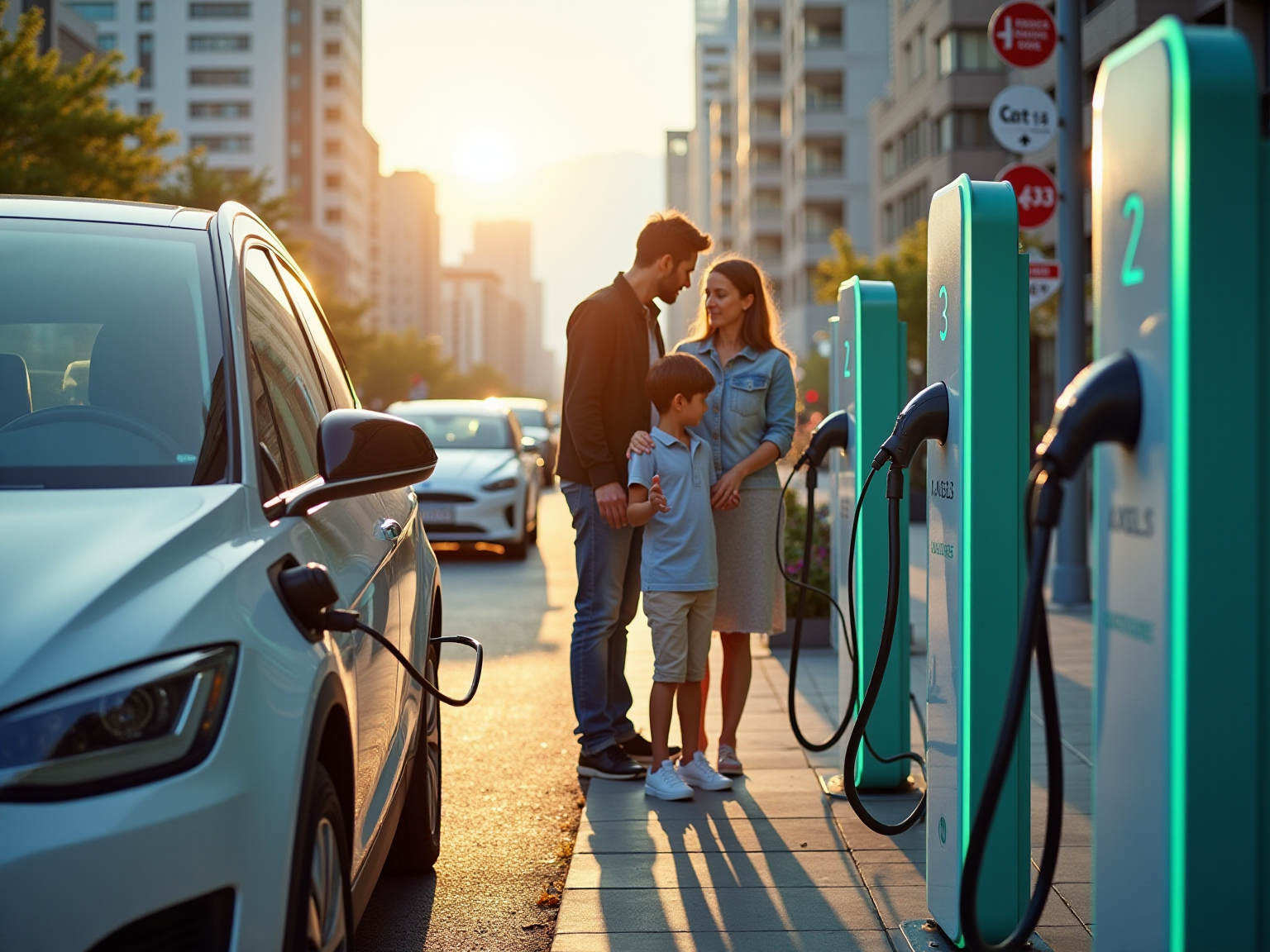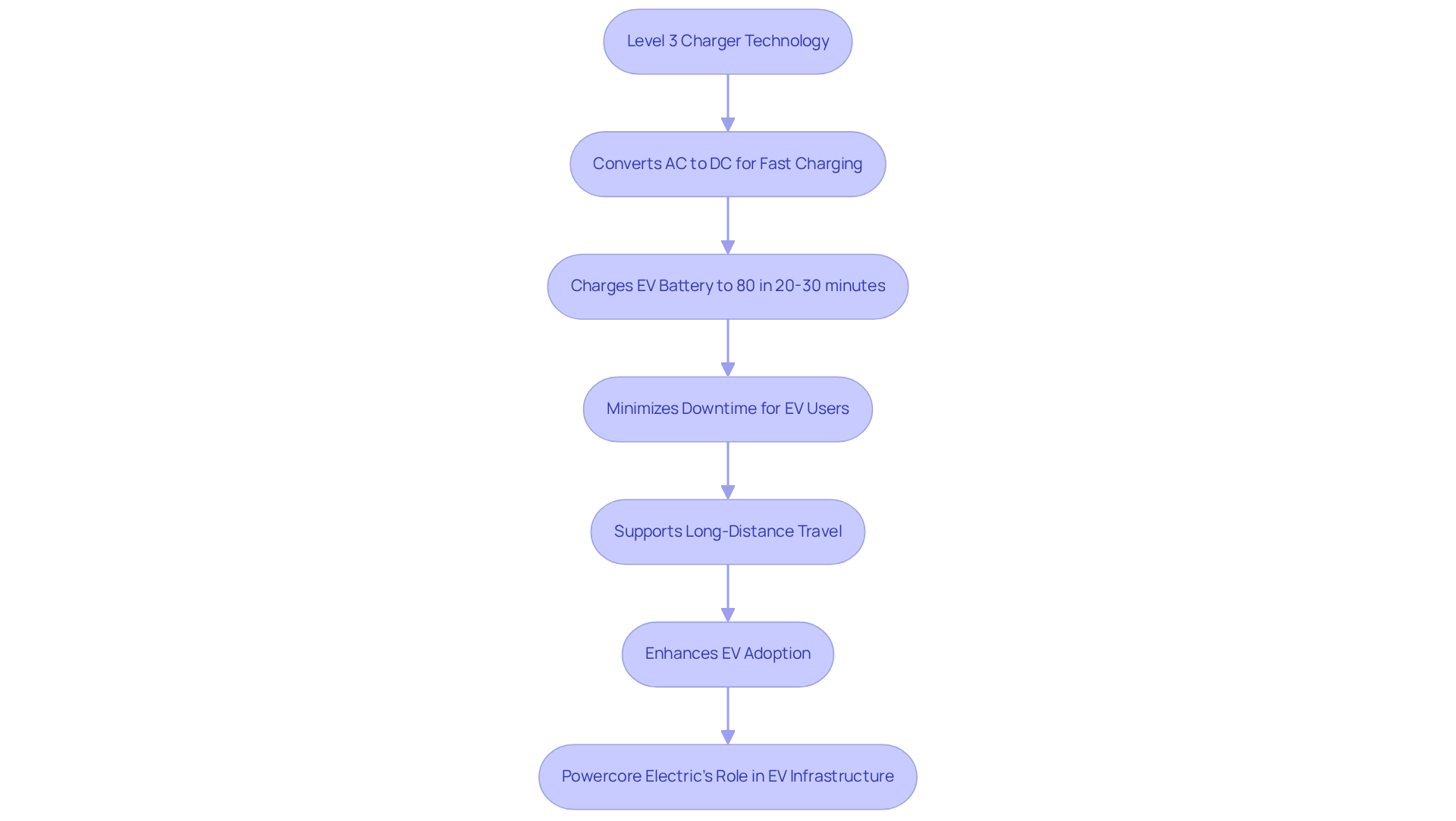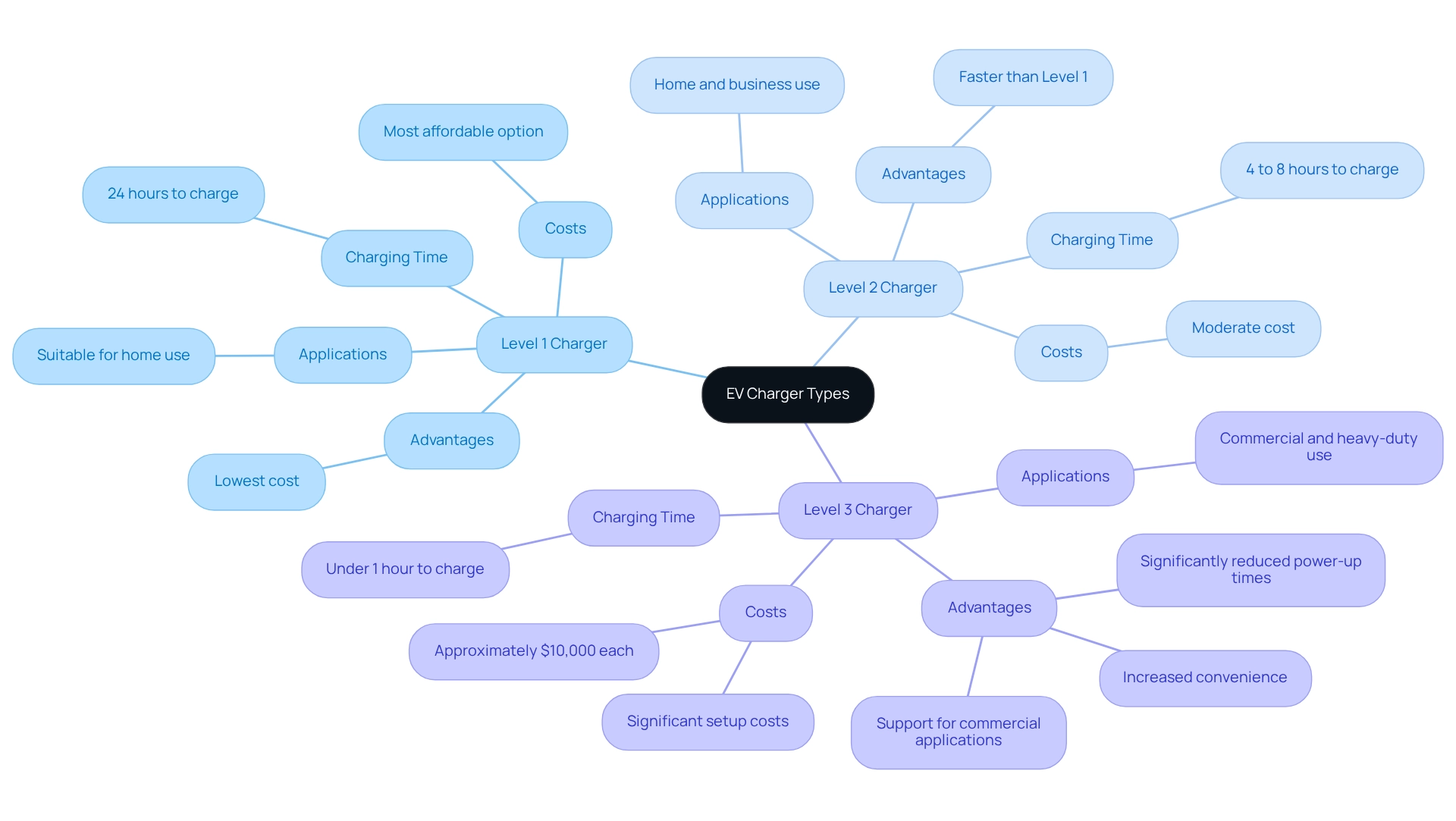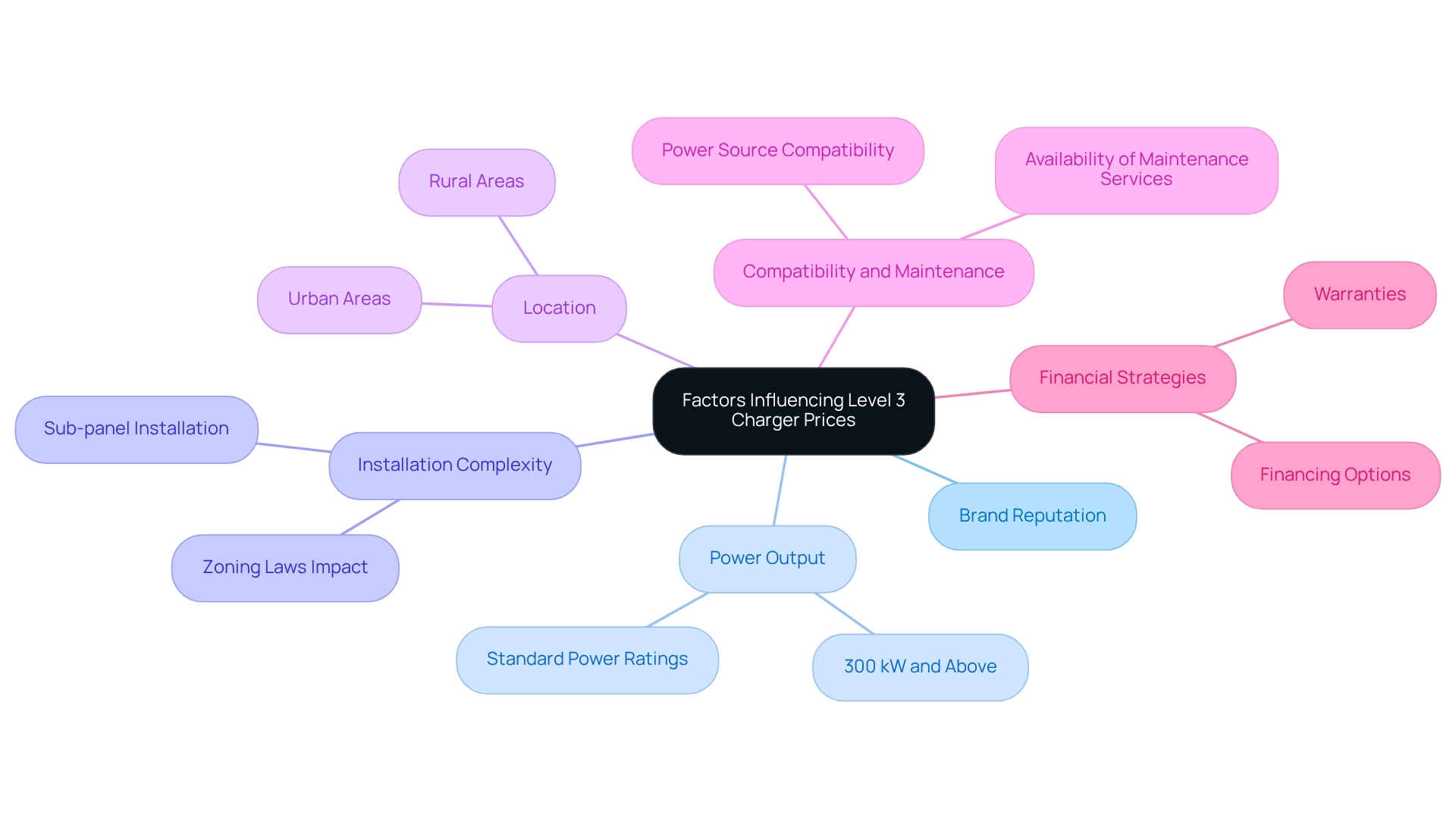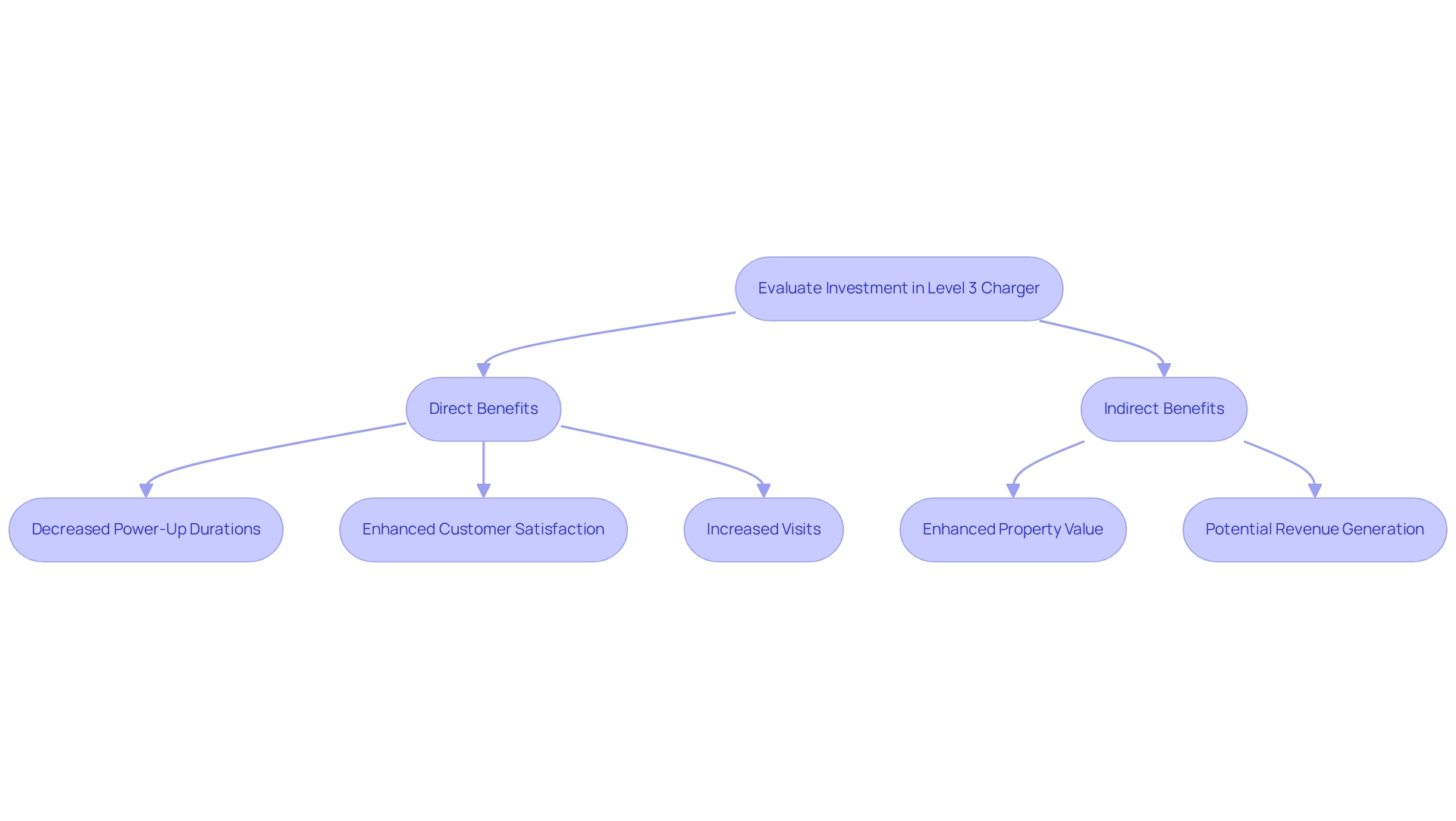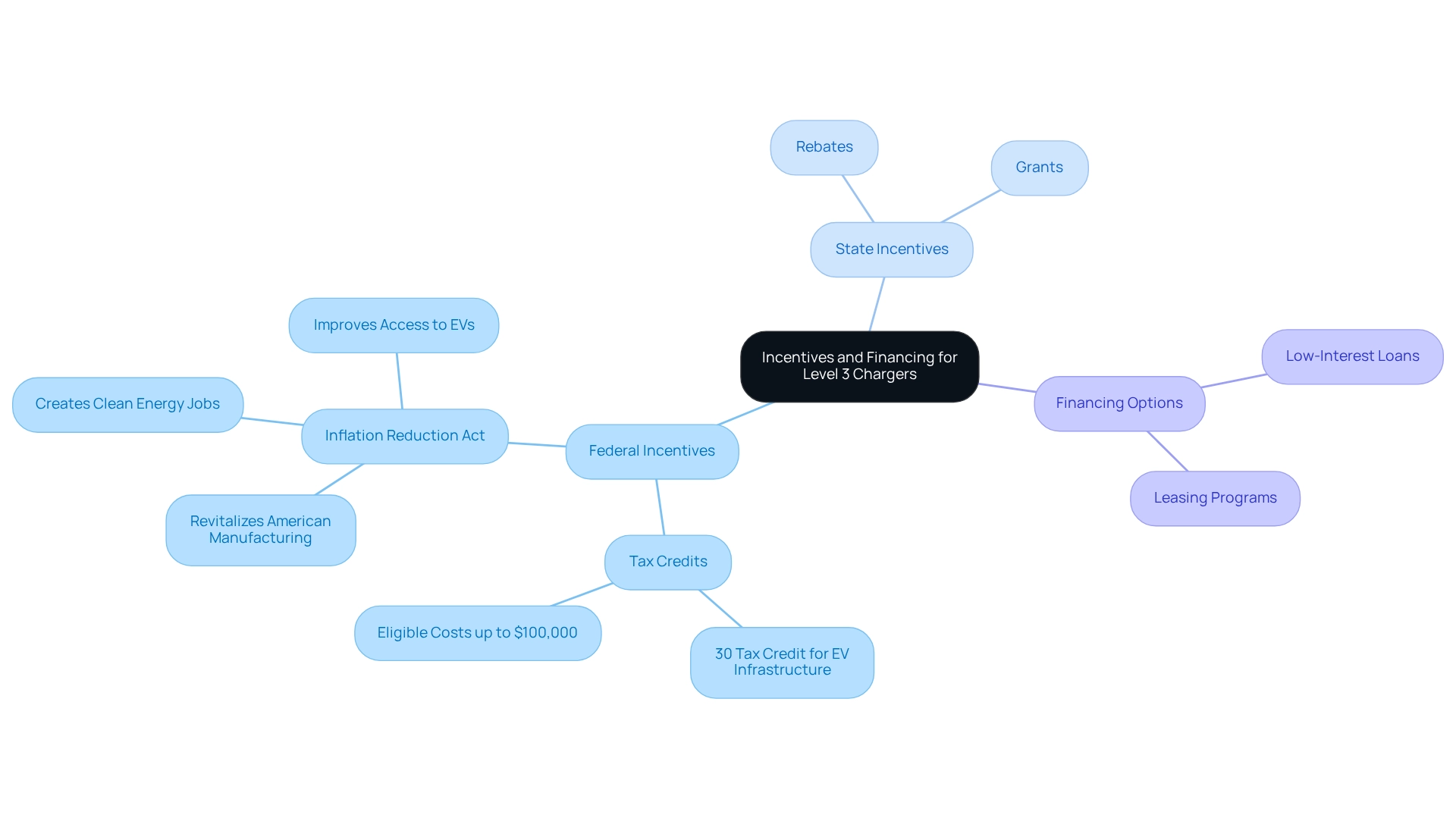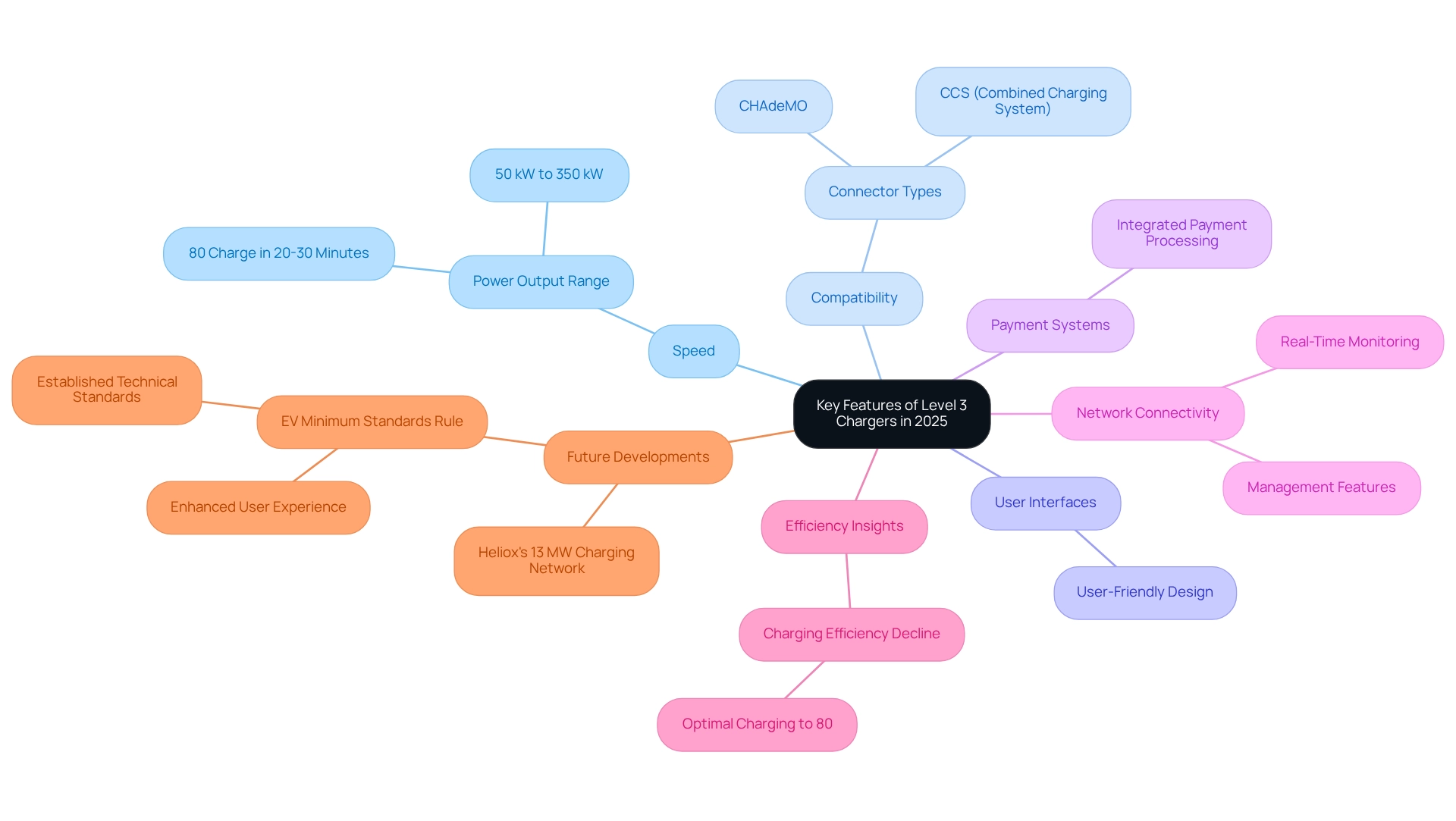Overview
This article addresses the costs associated with Level 3 chargers, recognizing their vital role in the electric vehicle ecosystem and the various factors that influence their pricing. We understand that installation costs for these chargers can be a significant concern, ranging from $10,000 to $50,000. Factors such as power output and installation complexity play a crucial role in these costs. However, it’s important to consider the long-term benefits and potential return on investment for consumers who are contemplating the adoption of these devices. Together, we can explore how these chargers contribute to a sustainable future and help alleviate some of the worries surrounding energy expenses.
Introduction
As electric vehicles (EVs) continue to gain traction in our automotive landscape, we understand that the demand for efficient and rapid charging solutions is becoming increasingly critical. Level 3 chargers, known as DC fast chargers, stand at the forefront of this revolution, offering the capability to charge an EV to approximately 80% in just 20 to 30 minutes. This remarkable efficiency alleviates range anxiety for drivers, providing peace of mind as we navigate this new era of transportation. Moreover, it supports the growing infrastructure necessary for widespread EV adoption, which is essential for our collective journey towards sustainability.
We recognize that the importance of these chargers extends beyond personal convenience; they play a vital role in commercial applications and broader sustainability efforts. Understanding their impact, costs, and features is essential for both consumers and businesses alike. As the electric vehicle market expands, so too does the need for informed decisions about charging solutions that align with our evolving energy needs and environmental goals. Together, we can embrace these innovations and work towards a more sustainable future.
What is a Level 3 Charger and Why is it Important?
Type 3 power sources, often known as DC fast units, are designed with your needs in mind, providing significant energy directly to electric vehicles (EVs) for swift charging capabilities. Unlike their first and second counterparts that utilize alternating current (AC), Type 3 devices convert AC to direct current (DC) within the unit itself. This advanced technology allows them to charge an EV’s battery to approximately 80% in just 20 to 30 minutes, making them indispensable for long-distance travel and business applications.
We understand that the importance of tier 3 stations extends beyond mere convenience; they play a crucial role in minimizing downtime for EV users, enhancing the practicality of electric vehicle ownership. As California leads the nation in the accessibility of public EV power stations, the need for effective replenishment solutions is more vital than ever. In fact, ChargePoint, a key player in the EV power supply market, accounts for 42.9% of all power locations across the United States, showcasing the growing infrastructure that supports electric vehicles.
At Powercore Electric, our dedicated team of specialists ensures high-quality installations of Level 3 devices, helping you navigate the level 3 charger price with clarity. Our commitment to transparency and community focus resonates with eco-conscious homeowners, making us a reliable partner for your EV charging needs. Additionally, we offer a range of services, including solar panels and battery backups, further promoting sustainable energy practices.
Real-world examples of DC fast charging installations by Powercore Electric illustrate our impact on electric vehicle adoption. Companies that have integrated third-tier charging stations into their operations not only provide essential services to clients but also position themselves as leaders in sustainability. This trend is crucial as the adoption of electric vehicles rises, with level 3 charger price being a key factor in alleviating range anxiety for prospective EV owners.
In summary, the significance of Level 3 stations cannot be overstated. They are essential for facilitating long-distance travel, supporting commercial use, and ultimately driving the widespread adoption of electric vehicles. As technology continues to evolve, the role of these devices in the EV ecosystem will only become more important.
For more information on Powercore Electric’s services, including solar panels, battery backups, and EV charging stations, we invite you to reach out to us at ryan.serrano@powercoreinc.net or call us at (916) 699-8778. Together, we can work towards a more sustainable future.
Breaking Down the Costs: Installation and Operation of Level 3 Chargers
We understand that expenses related to Tier 3 charging units can fluctuate considerably, which can be a source of concern for many homeowners. Setup costs typically range from $10,000 to $50,000, largely determined by the complexity of the installation and the extent of necessary electrical upgrades. For instance, setup expenses for Type 2 devices usually vary from $2,000 to $7,000, depending on the specific needs of your property.
Additionally, operational costs—including electricity rates, maintenance, and network fees—can add an extra $400 to $1,000 annually. Being aware of both setup and operational costs is vital for eco-conscious homeowners considering the implementation of a level 3 charger, as these expenses significantly influence the overall return on investment (ROI). For example, utilizing a Fast DC power supply for an annual distance of 13,489 miles might lead to costs between approximately $1,540 and $2,300, highlighting the importance of assessing long-term financial consequences.
Utilizing licensed setup services, such as those provided by Powercore Electric, is crucial not only for compliance and safety but also for enhancing the efficiency and lifespan of your charging systems. Our detailed setup procedure includes:
- An exhaustive site evaluation to identify the best position for the device
- Necessary electrical enhancements to support the system
- Thorough testing to ensure that everything operates efficiently before handover
As one satisfied customer shared, “Powercore Electric made the installation process seamless and efficient, ensuring everything was up to code and working perfectly.”
It’s important to recognize that while Tier 3 devices are primarily available for commercial purposes, understanding the level 3 charger price and its benefits can empower homeowners to make informed choices regarding their electric vehicle power solutions. Together, we can navigate these decisions and work towards a more sustainable future.
Level 3 vs. Level 1 and Level 2 Chargers: Key Differences and Benefits
For many homeowners, the rising energy bills can be a source of concern. Type 1 devices represent the most fundamental choice for electric vehicle (EV) power supply, utilizing standard 120V outlets. While they can take up to 24 hours to fully charge an EV, they are primarily suitable for overnight home use. On the other hand, Type 2 devices operate on 240V and significantly reduce charging time to around 4 to 8 hours, making them a preferred option for both home and business applications.
We understand that time efficiency is crucial, especially for those with busy schedules. Type 3 units, often referred to as DC fast systems, stand out by providing a complete power-up in less than an hour. This remarkable capability is particularly beneficial in business environments and during long journeys. The key advantages of Tier 3 devices include:
- Significantly Reduced Power-Up Times: With the ability to energize an EV in under an hour, Tier 3 units cater to users who need quick turnaround times, especially in bustling commercial settings.
- Increased Convenience: The rapid power-up feature allows for more efficient use of power stations, accommodating a higher volume of vehicles—essential for public infrastructure.
- Support for Commercial Applications: Tier 3 devices are perfect for businesses that need to keep their fleet of EVs operational without extended downtimes, enhancing productivity and service delivery. They are specifically designed for commercial and heavy-duty electric vehicles, making them ideal for high-traffic zones.
Regarding expense, Tier 3 units, reflecting the level 3 charger price, are the most expensive option, typically costing around $10,000 each, along with significant setup costs. However, this investment is justified by the substantial benefits they offer, particularly in high-traffic areas where quick charging is essential. As the demand for EVs continues to grow, the role of Level 3 charging stations in supporting commercial applications will become increasingly vital, ensuring that businesses can efficiently meet their customers’ needs.
At Powercore Electric, we take pride in offering customized service solutions to meet our customers’ precise specifications, including the installation of Level 3 charging stations. Our setup services ensure that the devices are arranged properly and effectively, enhancing their performance. Powercore Electric’s commitment to community-oriented setups of charging stations further enriches our service to California homeowners and businesses, establishing us as a reliable partner in integrating electric vehicles with renewable energy solutions. Together, we can work towards a more sustainable future.
Factors Influencing Level 3 Charger Prices: What to Consider
We understand that homeowners are increasingly concerned about rising energy bills and the costs associated with electric vehicle charging. The price of a level 3 charger can be influenced by several key factors, including:
- Brand reputation
- Power output
- Complexity of installation
High-capacity power supplies, especially those rated at 300 kW and above, often come with higher costs due to their advanced technology and the extensive infrastructure required for setup.
Location plays a significant role as well; urban areas frequently face increased installation expenses due to strict zoning laws and elevated labor rates. For instance, the typical electrical panel capacity in home environments usually varies from 60 to 200 amps, which can affect the compatibility and installation needs of third-tier devices.
Moreover, the compatibility of power sources with various electric vehicle models and the availability of maintenance services are crucial factors that can impact long-term ownership costs. As Ralf Hug, Global Head of Product Management & Marketing, wisely noted, “Their expertise allows us to make data-driven, strategic decisions and ensures we remain aligned with the latest trends and opportunities in the market.” This highlights the importance of knowledgeable decision-making when evaluating third-tier charging devices.
It’s common to feel overwhelmed by the financial landscape of electric vehicle ownership. However, as highlighted in recent case studies, strategies such as financing options and warranties can help consumers navigate these costs effectively. Additionally, while setting up a sub-panel during EV power point installation may raise initial expenses, it can be beneficial for future electrification initiatives.
In 2025, understanding these factors will be essential for homeowners looking to invest in high-capacity Type 3 devices, particularly regarding level 3 charger pricing. This knowledge will empower them to make informed choices that align with their energy needs and budget. With the in-house team of experts at Powercore Electric, who have proudly served California for over 30 years, homeowners can trust that they will receive high-quality installations and maintenance. Together, we can ensure reliable service and sustainable energy solutions, further supporting your investment in eco-friendly technologies.
Evaluating the ROI: Is a Level 3 Charger Worth the Investment?
We understand that many homeowners are concerned about rising energy bills and the impact of traditional energy sources on the environment. Investing in a Type 3 charging device can be a significant step towards addressing these concerns, offering both direct and indirect benefits that resonate with your values, especially when considering solar energy as an alternative to conventional electricity.
Direct advantages are compelling. With decreased power-up durations and enhanced customer satisfaction, you may find that these charging stations lead to higher usage rates. For example, businesses that install third-tier charging stations often notice an increase in customer visits, as these devices significantly reduce wait times for electric vehicle (EV) owners. This efficiency not only enhances the customer experience but also encourages repeat visits, fostering a loyal customer base. Consider the Fiat 500e owners, who, with an average household income of $145,000, are likely to appreciate the convenience of rapid charging options.
Moreover, the indirect benefits are equally noteworthy. A strategically placed Type 3 charging station can enhance property value, attracting environmentally conscious customers and businesses. Research shows that properties equipped with EV charging capabilities can command a premium in the market, making your investment not just practical but also valuable.
The case study titled ‘Types of EV Refueling Infrastructure‘ underscores the importance of understanding various refueling stations, including Type 3 units, and their role in the broader EV landscape. This knowledge is essential for making informed decisions that align with your sustainable goals.
Financially, the potential of a Level 3 device extends to generating revenue through charging fees, which can be influenced by the pricing of these chargers. In high-traffic areas, installing these devices can transform into a profitable investment, providing a steady income stream while supporting the growing demand for EV infrastructure. As Anand Manthena, Director at PwC US, notes, “A national network of charging stations that meets customer demand and preferences will greatly aid in the increased adoption of EVs.”
Looking ahead, the market for at-work charging is projected to expand significantly, potentially reaching 17% by 2030. Similarly, multi-unit residential segments are expected to rise to about 15% in 2025 and 17% in 2030. By investing in third-tier charging stations now, you position yourself favorably for future growth, especially as you consider integrating solar energy solutions.
In summary, the direct and indirect advantages of investing in a Type 3 charging station not only enhance customer satisfaction and property value but also present a promising opportunity for revenue generation. Together, we can work towards a more sustainable future, making this a strategic choice for forward-thinking companies eager to embrace solar energy for efficient and eco-friendly operations.
Incentives and Financing: Making Level 3 Chargers More Affordable
We understand that managing energy costs can be a significant concern for homeowners. Fortunately, several federal and state incentives are available to help reduce the expenses associated with acquiring and setting up a level 3 charger, making home EV refueling not only straightforward but also economical. The federal tax credit for EV power equipment allows for a deduction of up to 30% of the total setup cost for infrastructure installed through December 31, 2032. This notably eases the financial burden on property owners and businesses alike, promoting the acceptance of electric vehicles.
In addition to this federal support, many states offer rebates and grants specifically designed to encourage the installation of EV charging stations. These incentives further lower the financial barriers to entry, facilitating a smoother transition for environmentally conscious homeowners looking to adopt electric vehicle power sources at home. This ensures that you can power your vehicles safely and conveniently.
Financing options also play a crucial role in making the level 3 charger price more accessible. Low-interest loans and leasing programs enable businesses and homeowners to invest in electric vehicle infrastructure without straining their budgets. These financial solutions can pave the way for a seamless transition to electric vehicle adoption, ensuring that the necessary refueling infrastructure is in place to support the growing demand.
Statistics indicate a notable increase in the uptake of EV incentive programs, with 288 modifications to incentive offerings occurring in 2023 alone—double the number from the previous year. This increase reflects a broader commitment to enhancing electric vehicle infrastructure, supported by measures such as the Inflation Reduction Act, which aims to rejuvenate American manufacturing, create clean energy jobs, and improve access to clean energy options.
As we look ahead to 2025, the landscape for federal and state incentives for electric vehicle charging systems continues to evolve, providing a solid foundation for those considering advanced charging investments. Case studies highlight the importance of strategic planning, procurement, and installation of power infrastructure to meet the rising demand for electric vehicles, ensuring that adequate power options are available for users. Together, we can navigate this journey towards sustainable energy solutions.
Key Features of Level 3 Chargers: Speed, Compatibility, and More
We understand that navigating energy costs can be a significant concern for many homeowners. Type 3 devices stand out for their remarkable swift power delivery features, offering energy outputs typically ranging from 50 kW to 350 kW. This impressive range allows most electric vehicles (EVs) to achieve approximately 80% charge in just 20 to 30 minutes, significantly reducing downtime for users. Compatibility plays a crucial role in the efficiency of Type 3 devices; numerous models are designed to accommodate various connector types, including CCS (Combined Charging System) and CHAdeMO, enhancing their applicability across different EV brands and models.
As we look towards 2025, the features of Level 3 chargers have evolved to include user-friendly interfaces that enrich the experience, integrated payment processing systems for seamless transactions, and advanced network connectivity that facilitates real-time monitoring and management. These enhancements not only improve user convenience but also contribute to the overall efficiency of the charging process, addressing the needs of modern electric vehicle owners.
Recent developments in EV infrastructure, such as the introduction of the EV Minimum Standards Rule by the FHWA in February 2023, have established essential technical standards for federally funded refueling stations. This initiative aims to ensure compatibility and reliability, thereby enhancing the user experience for EV drivers. By adhering to these standards, Type 3 charging stations are becoming more dependable and accessible, further supporting the growing acceptance of electric vehicles.
Statistics indicate that as the refueling process nears full capacity, efficiency tends to decline. Therefore, it is often more beneficial to utilize DC fast replenishment until the battery reaches around 80% charge. This insight underscores the importance of third-tier stations in optimizing power refill times and improving the overall effectiveness of electric vehicle usage. As Ralf Hug, Global Head of Product Management & Marketing, notes, “Their expertise allows us to make data-driven, strategic decisions and ensures we remain aligned with the latest trends and opportunities in the market,” emphasizing the significance of these advancements in the EV sector.
Furthermore, Heliox’s 13 MW power network for electric buses exemplifies the expanding infrastructure that supports tier 3 refueling capabilities, suggesting a robust ecosystem for electric mobility.
In summary, the key attributes of Level 3 devices in 2025 include their swift power delivery capabilities, extensive compatibility with various EV models, and advanced features that cater to the evolving needs of electric vehicle owners. For eco-conscious homeowners, these devices not only provide energy efficiency but also lead to substantial cost savings, positioning them as a vital investment in sustainable living. Together, we can explore how Powercore Electric can support you with EV power stations, solar panels, and battery backups. Please feel free to reach out to us at ryan.serrano@powercoreinc.net or call (916) 699-8778.
Choosing the Right Level 3 Charger: Tips for Consumers
When considering a Level 3 device, it’s essential to reflect on several critical factors, including the level 3 charger price, to ensure you achieve optimal performance and value. First and foremost, think about the charging speed, as this directly impacts how quickly your electric vehicle (EV) can recharge. Chargers with higher power outputs are particularly advantageous for commercial applications where high traffic is anticipated, enabling faster turnaround times for vehicles.
We understand that compatibility with your specific EV model is another crucial consideration. Not all chargers are suitable for every vehicle, so it’s vital to confirm that the charger aligns with your EV’s requirements. Additionally, setup requirements can vary significantly; grasping the electrical infrastructure of your home or business will help you identify what modifications may be necessary.
Evaluating the total cost of ownership, especially the level 3 charger price, is vital for making an informed decision. This involves not just the initial purchase cost but also the level 3 charger price, setup, maintenance, and operational expenses over time. For instance, while a larger initial expenditure on a more capable device might seem daunting, it could lead to reduced long-term expenses due to shorter power-up durations and enhanced efficiency.
Moreover, with the electric vehicle market projected to grow by 22% in 2024, and California leading the charge with EVs accounting for 25% of new vehicle purchases, researching the level 3 charger price along with available incentives and financing options can significantly enhance your investment. Many states offer rebates or tax credits for EV station installations, which can alleviate costs. Notably, EVs now constitute more than 10% of new automobile sales in nine states, underscoring the increasing demand for charging infrastructure.
As Anand Manthena, Director at PwC US, states, “A national network of charging stations that satisfies customer demand and preferences will do much to support greater adoption of EVs.” This highlights the importance of selecting the right third-tier device to ensure compatibility with the expanding EV market.
Consulting with a professional installer, such as Powercore Electric, can provide tailored recommendations based on your specific circumstances, ensuring that you choose a Level 3 charger that aligns with your needs and maximizes your investment. Powercore Electric offers a range of services, including detailed EV charging stations, solar panels, and battery backups, which can beautifully complement your EV charging setup. As the demand for EVs continues to rise, understanding these factors will be crucial for making a smart and sustainable choice.
Conclusion
Investing in Level 3 chargers is not just a strategic decision; it’s a step towards enhancing the electric vehicle (EV) experience for both consumers and businesses. We understand that range anxiety can be a significant concern for many, and these chargers, with their rapid charging capabilities and compatibility with multiple EV models, help alleviate that worry. They also support the growing infrastructure necessary for widespread EV adoption, which is crucial for our collective journey towards sustainable transportation.
The benefits of Level 3 chargers extend far beyond mere convenience. They contribute to increased customer satisfaction, boost property values, and present opportunities for revenue generation through charging fees. With the continued evolution of incentives and financing options, installing these chargers has become more accessible than ever. This accessibility empowers eco-conscious homeowners and businesses to make informed investments in their future, fostering a sense of community and shared responsibility.
As the electric vehicle market continues to expand, the necessity for efficient charging solutions grows stronger. By prioritizing the installation of Level 3 chargers, individuals and organizations not only enhance their operational capabilities but also align themselves with the broader goals of sustainability and environmental responsibility. Together, we can embrace these advancements, navigating the future of transportation and ensuring a cleaner, greener planet for generations to come. Let’s work towards a sustainable future, one charge at a time.


